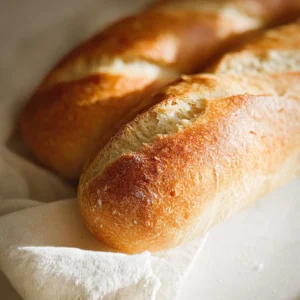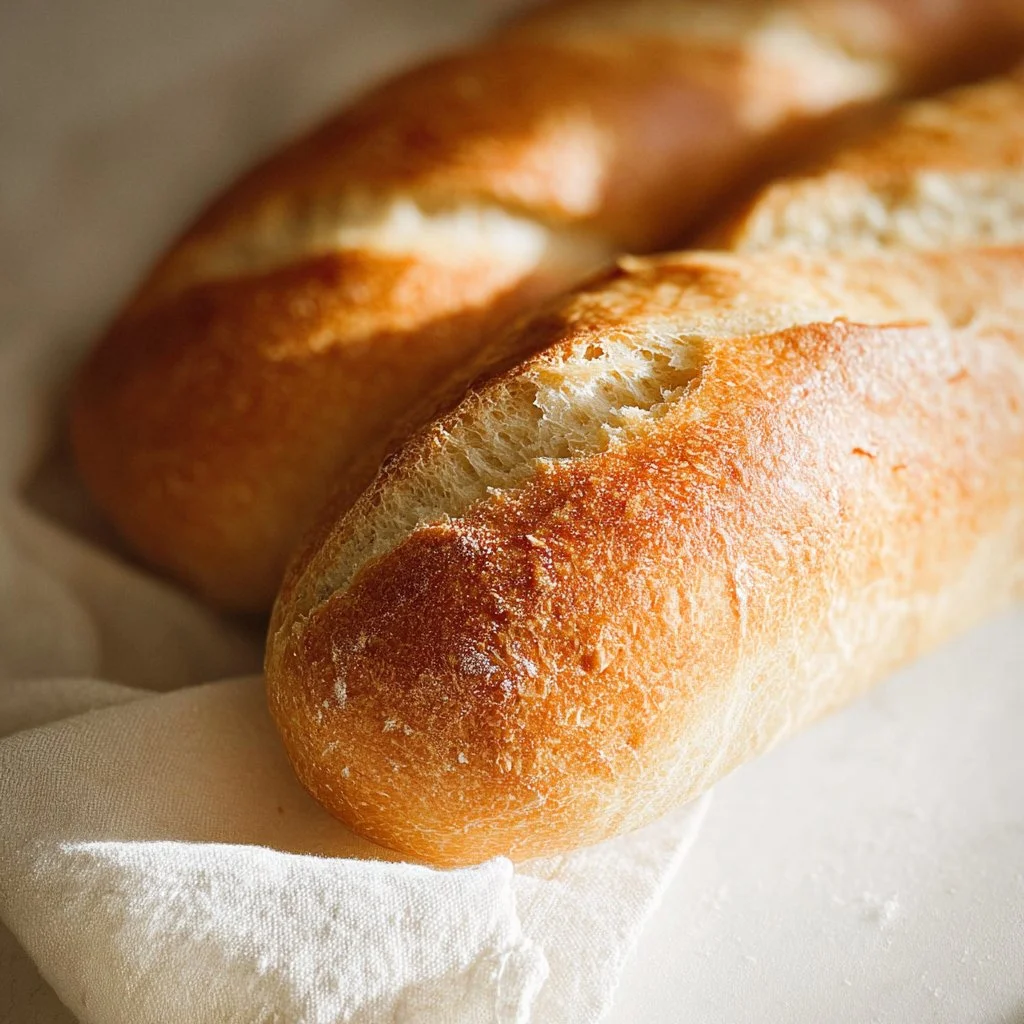French bread, with its crisp crust and soft, airy interior, is a staple that graces tables around the world. Known for its distinctive shape and incredible flavor, this beloved bread has captured the hearts of many home bakers and food enthusiasts alike. Its versatility makes it perfect for everything from sandwiches to elegant sides for a cozy dinner. In this guide, you’ll not only learn how to bake your own French bread but also discover tips, variations, and serving suggestions that will elevate your baking game.
Why We Love This French Bread Recipe
The appeal of French bread goes beyond its delightful taste and texture. It embodies simplicity, using just a handful of ingredients that you likely already have in your kitchen. Preparing your own bread at home can be a joyful and therapeutic experience, allowing you to fill your kitchen with inviting aromas while engaging in the art of baking. Furthermore, nothing compares to the satisfaction of pulling warm, freshly baked bread from the oven, ready to be enjoyed. This recipe sets you on a path to create perfect loaves every time, with clear guidance and tried-and-true methods.
Ingredients for French Bread
To start your journey into homemade French bread, gather the following ingredients:
- Warm Water: 2 1/4 cups (between 112° to 115°F)
- Sugar: 2 teaspoons
- Active Yeast: 1 packet (about 2 1/4 teaspoons)
- Sea Salt: 2 teaspoons
- Softened Unsalted Butter: 2 teaspoons
- Bread Flour: 5 cups
These simple ingredients come together to create the perfect loaf that’s perfect for any occasion.
How to Make French Bread Directions
Now that you have your ingredients ready, let’s dive into the preparation process. Making French bread might seem daunting at first, but with these steps, you’ll find it quite straightforward.
Activate the Yeast: Begin by adding half of the warm water to a mixing bowl. Sprinkle in the sugar and yeast, then whisk gently. Set it aside for about 5 to 7 minutes until it becomes frothy. This step is crucial to ensure that your yeast is alive and active.
Mix the Ingredients: Once the yeast is activated, add the remaining warm water, sea salt, softened butter, and the bread flour to the bowl. Mix everything together until combined into a rough dough.
Knead the Dough: If you have a stand mixer, attach the dough hook and knead the dough on low speed for about 8 to 10 minutes until it’s smooth and elastic. If you don’t have a mixer, you can also knead by hand on a floured surface. Just make sure to put in a bit of elbow grease!
Proof the Dough: Place the kneaded dough in a lightly greased bowl, covering it with plastic wrap or a clean kitchen towel. Allow it to proof in a warm spot for approximately 90 minutes, or until it has doubled in size. This fermentation process develops flavor and structure.
Shape the Loaves: Once your dough has risen beautifully, punch it down to release the air. Transfer it to a floured surface and knead gently for 1 to 2 minutes. Divide the dough into equal parts based on how many loaves you want. Shape each piece into a loaf according to your preference and place them on a baking sheet. Let them proof again for about 60 minutes.
Preheat the Oven: While the loaves are finalizing their rise, preheat your oven to 425°F (220°C). To create a lovely crust, place a shallow pan filled with water at the bottom of the oven.
Score and Bake: Before baking, use a sharp knife or razor blade to score the tops of the loaves. This helps with even baking and gives the bread its classic look. Bake the loaves for 22 to 25 minutes, or until they are golden brown and sound hollow when tapped on the bottom.
Cool Down: After baking, let the loaves cool completely on a wire rack before slicing. This will help set the interior and make sure your loaves don’t become soggy.
How to Serve French Bread
Now that you’ve successfully baked your French bread, it’s time to think about how to serve it. This bread pairs wonderfully with a variety of dishes, making it a perfect addition to any meal. Here are some delightful serving ideas:
As a Side: French bread makes an excellent accompaniment to soups and stews. Its crusty texture is perfect for dipping, enhancing the dining experience.
With Spreads: Serve slices with butter or a selection of spreads like hummus, pesto, or herb-infused olive oil. This will elevate your serving presentation and offer a mix of flavors.
For Sandwiches: Create amazing sandwiches filled with your favorite fillings, whether it’s vegetables, meats, or cheeses. The robust crust holds everything together beautifully.
For Toast: Slice it up and toast it for breakfast or a snack, then top with your desired toppings such as avocado, eggs, or preserves.
French bread is versatile and can be enjoyed in numerous ways, making every meal even more delightful.
Expert Tips for French Bread
While making French bread is pretty straightforward, here are a few expert tips to ensure your loaves turn out perfect every time:
Temperature Matters: Ensure that your water is at the right temperature. Too hot can kill the yeast; too cold can slow down the activation. Stick to 112° to 115°F for optimal results.
Kneading Time: Don’t rush the kneading process; it’s essential for gluten development, which gives bread its structure and chewiness.
Use Quality Flour: For the best texture, using high-protein bread flour is recommended. It has a higher gluten content than all-purpose flour, helping you achieve that classic French bread structure.
Humidity: If you live in a very humid environment, you may need to adjust the amount of flour you use. Consider starting with a little less and adding as needed until the dough reaches the desired consistency.
Experiment with Shapes: Don’t hesitate to try different shapes and sizes for your French bread. You can make baguettes, round loaves, or even small rolls, depending on your needs.
How to Store French Bread
Storing your freshly baked French bread properly is essential for maintaining its flavor and texture. Here’s how to do it:
Cool Completely: Make sure the bread is fully cooled before storing to prevent moisture from creating a soggy loaf.
Wrap It Up: Use a clean kitchen towel to wrap your bread. This allows the bread to breathe while keeping the crust from becoming too soft.
Plastic Bag for Storage: If you prefer a softer crust, you can place it in a plastic bag once it has cooled. However, it’s best consumed within a few days.
Freezing: For longer storage, you can freeze French bread. Slice it before freezing to make it easier to toast later. Wrap in plastic wrap and then place in a freezer bag to preserve freshness.
Variations of French Bread
While the classic French bread recipe is amazing on its own, trying out variations can be a fun way to explore new flavors. Here are some ideas to inspire you:
Herbed Bread: Incorporate dried herbs like rosemary, thyme, or oregano into your dough for a fragrant twist that enhances the flavor profile.
Garlic French Bread: Add minced garlic to the softened butter before applying it to your loaves post-baking for a tasty garlic bread option.
Cheese-Stuffed Bread: Before shaping your loaves, flatten the dough and add your favorite cheese, then roll it up to create cheesy goodness in the center of your bread.
Whole Wheat French Bread: Substitute a portion of the bread flour with whole wheat flour for a healthier option that still delivers on taste and texture.
Olive Oil Bread: Replace butter with olive oil for a Mediterranean twist. This variation adds a unique flavor and is perfect when served with dips.
FAQ
What is French bread?
French bread is a type of elongated white bread known for its crispy crust and soft interior, commonly used for sandwiches or enjoyed alongside meals.
How can I prevent my French bread from getting hard?
To prevent your bread from becoming hard, store it properly in a bread box or wrapped in a towel. Avoid refrigerating, as this can dry it out.
Why is my French bread dense?
A dense loaf could be due to under-kneading the dough or using old yeast. Ensuring that your yeast is fresh and kneading adequately are key factors in achieving light, airy bread.
Can I make French bread ahead of time?
Yes, you can make French bread in advance and either freeze it or bake it until slightly underdone and then finish baking before serving.
What is the ideal serving temperature for French bread?
French bread tastes best when served warm, just out of the oven or reheated slightly in the oven or toaster before serving.

French Bread
Equipment
- Mixing Bowls:
- Baking Sheet
- Kitchen towel
- Oven
Ingredients
- 2 1/4 cups warm water between 112° to 115°F
- 2 tsp sugar
- 1 packet active yeast about 2 1/4 teaspoons
- 2 tsp sea salt
- 2 tsp softened unsalted butter
- 5 cups bread flour
Instructions
- In a mixing bowl, add half of the warm water. Sprinkle in sugar and yeast; whisk gently. Let it sit for 5-7 minutes until frothy.
- Add the remaining warm water, sea salt, softened butter, and bread flour to the bowl. Mix until combined into a rough dough.
- Knead the dough on a floured surface or use a stand mixer with a dough hook on low speed for 8-10 minutes until smooth and elastic.
- Place the kneaded dough in a greased bowl, cover with plastic wrap or a kitchen towel, and let it proof in a warm spot for about 90 minutes, or until doubled in size.
- Punch down the dough to release air. Transfer to a floured surface, knead gently, and divide into equal parts for shaping.
- Shape each piece into a loaf and place them on a baking sheet. Allow them to proof for another 60 minutes.
- Preheat your oven to 425°F (220°C) and place a shallow pan filled with water at the bottom.
- Score the tops of the loaves with a sharp knife to promote even baking. Bake for 22-25 minutes until golden brown and hollow sounding when tapped.
- Cool the loaves completely on a wire rack before slicing.
Send me this recipe!
Just enter your email below and get it sent straight to your inbox!



